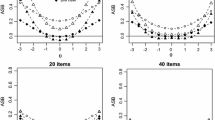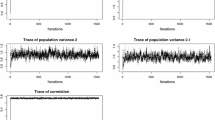Abstract
In this paper we deal with the problem of estimating item and population ability parameters in longitudinal studies where a group of individuals is submitted to different tests along the time, with some common items. Several covariance structures are explored to model the possible dependency between the abilities of the same individual, measured at different instants. Maximum likelihood equations and some simulation results are presented.
Similar content being viewed by others
References
Andrade, D. F. andTavares, H. R. (2005). Item response theory for longitudinal data: population parameter estimation.Journal of Multivariate Analysis, 95:1–22.
Andrade, D. F., Tavares, H. R., andValle, R. C. (2000).Item Response Theory: Concepts and Applications. Associação Brasileira de Estatística, São Paulo. In Portuguese.
Baker, F. B. (1992).Item Response Theory—Parameter Estimation Techniques, Marcel Dekker, Inc., New York.
Bock, R. D. andAitkin, M. (1981). Marginal maximum likelihood estimation of item parameters: An application of a EM algorithm.Psychometrika, 46:433–459.
Bock, R. D. andZimowski, M. F. (1997). Multiple group IRT. In W. J. Van der Linder and R. K. Hambleton, eds.,Hanbook of Modern Item Response Theory Springer-Verlag, New York.
Bryk, A. S. andRaudenbush, S. W. (2002).Hierarchical Linear Models. Sage Publications, Newbury Park, CA, 2nd ed.
Chow, Y. S. andTeicher, H. (1978).Probability Theory: Independence, Interchangeability, Martingales, Springer-Verlag, New York.
Davidson, R. andMackinnon, J. G. (1993).Estimation and Inference in Econometrics, Oxford University Press, New York.
Doornik, J. A. (2000).Object-Oriented Matrix Programming Using Ox 2.0. Timberlake Consultants Ltd and Oxford, London. In www.nuff.ox.ac.uk/Users/Doornik.
Fox, J. P. (2003). Stochastic EM for estimating the parameters of a multilevel IRT model.British Journal of Mathematical and Statistical Psychology, 53:65–81.
Fox, J. P. andGlas, C. A. W. (2001). Bayesian estimation of a multilevel IRT model using Gibbs sampling.Psychometrika, 66:271–288.
Graybill, F. A. (1969).Introduction to Matrices with Aplications in Statistics, Wadsworth Publishing Company, Inc., Belmont, CA.
Hambleton, R. K., Swaminathan, H., andRogers, H. J. (1991).Fundamentals of Item Response Theory. Sage Publications, Newburg Park, CA.
Keselman, H. J., Algina, J., Kowalchuk, R. K., andWolfinger, R. D. (1998). A comparison of two approaches for selecting covariance structures in the analysis of repeated measurements.Communications in Statistics. Simulation and Computation, 27:591–604.
Laird, N. M. andWare, J. H. (1982). Random-effects models for longitudinal data.Biometrics, 38:963–974.
Lord, F. M. (1980).Applications of Item Response Theory to Practical Testing Problems. Lawrence Erlbaum Associates, Inc., Hillsdale.
Singer, J. M. andAndrade, D. F. (2000). Analysis of longitudinal data. In P. K. Sen and C. R. Rao, eds.,Bio-Environmental and Public Health Statistics, Vol. 18 ofHandbook of Statistics, pp. 115–160. North-Holland, Amsterdam.
Stroud, A. H. andSecrest, D. (1980).Gaussian Quadrature Formulas. Prentice-Hall, Englewood, New Jersey.
Tavares, H. R. andAndrade, D. F. (2001). Item response theory for longitudinal data: Item parameter estimation. Technical report, Department of Statistics, University of São Paulo, São Paulo, Brazil.
Author information
Authors and Affiliations
Corresponding author
Rights and permissions
About this article
Cite this article
Tavares, H.R., Andrade, D.F. Item response theory for longitudinal data: Item and population ability parameters estimation. TEST 15, 97–123 (2006). https://doi.org/10.1007/BF02595420
Received:
Accepted:
Published:
Issue Date:
DOI: https://doi.org/10.1007/BF02595420




